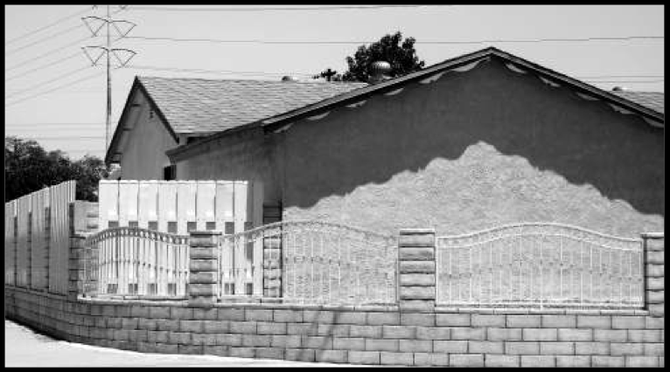 Facebook
Facebook
 X
X
 Instagram
Instagram
 TikTok
TikTok
 Youtube
Youtube

That first southbound walk home from Wegeforth Elementary, back in '68, was long and hot, each shadow on Mobley Street a refuge. For a transplanted fourth-grader, it was an arduous half-mile trek. These days, I never break a sweat on the drive back to my family home. I do slow down — children on bicycles remain common, though they wear plastic helmets now and the bikes cost more than several decades of inflation could account for. A bicycle was indispensable when I was growing up. Although the neighborhood may be nothing more than a canyon-locked mesa to an adult in a car, to an adolescent on a ten-speed it was a kingdom.
Seen from the air, Mobley traverses a peninsula jutting into the canyons. Side streets branch off here and there, following the lay of the land. It's a topography that repeats itself throughout Serra Mesa. Outsiders easily get lost, as many streets lead nowhere unless you live on them.
The intersection of Mobley and Gramercy Drive always seemed to me the heart of Serra Mesa. Coming north from my house, the traffic light there was the gateway to everywhere else. To the east, it was a short ride down and up a deep dip that took me to Taft Junior High. Beyond that, Gramercy becomes Mission Village Drive, which plunges downward to Qualcomm Stadium. Across from Taft, a fenced-off lot once held a Safeway, a bar, and a Thrifty drugstore, where ice cream was five cents a scoop well into the '70s.
If you head north through that traffic light, Mobley becomes Hammond Drive, a downhill curve that straightens after the next light and becomes Murray Ridge Road. Continuing on Murray Ridge you'll pass the new townhomes which replaced the original military housing that started the development back in the 1950s. In the '70s, I found it easier to coast my bike down the alley that runs parallel to Murray Ridge, a secret route to a friend's back yard where comic book swapping was the order of the day. Murray Ridge takes you over the 805 (where it becomes Phyllis Drive) and into the western reaches of Serra Mesa, which extends to the 163.
On the other hand, if you stand at that traffic light and turn south to face Mobley, you'll be looking at the essence of Serra Mesa. This is where the suburbs begin. Mobley runs almost straight south from this point, lined by tall trees and telephone lines, until it descends out of view to its final cul-de-sac a mile or so down. It's a tranquil place, far enough from the freeways that their rumble is reduced to a hum that does nothing to drown out birdsong. Twenty-five years ago, before dawn, you could hear signal bells from a railroad crossing to the west. Returning home, as I do, I get the feeling that little has changed, beyond the growth of the trees and the birth of new generations.


That first southbound walk home from Wegeforth Elementary, back in '68, was long and hot, each shadow on Mobley Street a refuge. For a transplanted fourth-grader, it was an arduous half-mile trek. These days, I never break a sweat on the drive back to my family home. I do slow down — children on bicycles remain common, though they wear plastic helmets now and the bikes cost more than several decades of inflation could account for. A bicycle was indispensable when I was growing up. Although the neighborhood may be nothing more than a canyon-locked mesa to an adult in a car, to an adolescent on a ten-speed it was a kingdom.
Seen from the air, Mobley traverses a peninsula jutting into the canyons. Side streets branch off here and there, following the lay of the land. It's a topography that repeats itself throughout Serra Mesa. Outsiders easily get lost, as many streets lead nowhere unless you live on them.
The intersection of Mobley and Gramercy Drive always seemed to me the heart of Serra Mesa. Coming north from my house, the traffic light there was the gateway to everywhere else. To the east, it was a short ride down and up a deep dip that took me to Taft Junior High. Beyond that, Gramercy becomes Mission Village Drive, which plunges downward to Qualcomm Stadium. Across from Taft, a fenced-off lot once held a Safeway, a bar, and a Thrifty drugstore, where ice cream was five cents a scoop well into the '70s.
If you head north through that traffic light, Mobley becomes Hammond Drive, a downhill curve that straightens after the next light and becomes Murray Ridge Road. Continuing on Murray Ridge you'll pass the new townhomes which replaced the original military housing that started the development back in the 1950s. In the '70s, I found it easier to coast my bike down the alley that runs parallel to Murray Ridge, a secret route to a friend's back yard where comic book swapping was the order of the day. Murray Ridge takes you over the 805 (where it becomes Phyllis Drive) and into the western reaches of Serra Mesa, which extends to the 163.
On the other hand, if you stand at that traffic light and turn south to face Mobley, you'll be looking at the essence of Serra Mesa. This is where the suburbs begin. Mobley runs almost straight south from this point, lined by tall trees and telephone lines, until it descends out of view to its final cul-de-sac a mile or so down. It's a tranquil place, far enough from the freeways that their rumble is reduced to a hum that does nothing to drown out birdsong. Twenty-five years ago, before dawn, you could hear signal bells from a railroad crossing to the west. Returning home, as I do, I get the feeling that little has changed, beyond the growth of the trees and the birth of new generations.
Comments